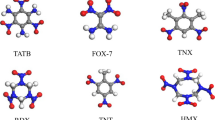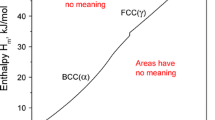Abstract
A theory that assumes the Engel-Brewer valence of elements (one for bcc structures, two for cph structures, and three for fcc structures) and considers the effects of balancing the solute and solvent Fermi energy levels and differences in zero point energy between solvent and solute atoms to calculate an “effective” relative valence for solute impurities is presented. The calculated values of relative valence and the experimental values of the differences in diffusional activation energy between solute and solvent atoms, ΔQ, are compared to the values of ΔH 2 + ΔE calculated from the Lazarus-LeClaire theory for several solute impurities in ten solvent metals. The calculated results agree very well with the experimental values for the large majority of solutes. The theory presented adequately describes solute impurity diffusion in both α-Fe and γ-Fe, Al, Ni, and the noble metals. In particular, the low activation energies for impurity diffusion of the alkali metals (ground state valence of one) in Al (ground state valence of three) are accounted for by the theory. It is shown that the diffusion of the electronegative solute impurities (Cr, Mn, Fe, and Co) in Al is not anomalous when the relative valence is calculated by the proposed theory. The diffusion of electronegative solute impurities in the noble metals, which has been problematic in the past, is also well described by the proposed theory. The proposed theory introduces a simple method of estimating the effective electron densities of solute impurities and illustrates that the Lazarus-LeClaire theory adequately describes solute impurity diffusion in the ten solvent metals studied. It is expected that more accurate calculations of effective electron density for solute impurities would result in even better agreement between experimental and calculated results.
Similar content being viewed by others
References
D. Lazarus: Phys. Rev., 1954, vol. 93, pp. 973–76.
A.D. LeClaire: Phil. Mag., 1962, vol. 7, pp. 141–67.
Bulbul Chakraborty, Lars C. Smedskjaer, and Steven J. Rothman: J. Phys., 1984, vol. F 14, pp. 301–08.
J.L. Deplante and A. Blandin: J. Phys. Chem. Solids, 1965, vol. 26, pp. 381–89.
W.B. Alexander and L.M. Slifkin: Phys. Rev. B, 1970, vol. 1, pp. 3274–82.
M.S. Anand and R.P. Agarwala: Phil. Mag., 1972, vol. 26, pp. 297–309.
S. Fujikawa and K. Hirano: Mater. Sci. Eng., 1977, vol. 27, pp. 25–33.
Shin-Ichiro Fujikawa, Ken-Ichi Hirano, and Yoshiaki Fukushima: Metall. Trans. A, 1978, vol. 9A, pp. 1811–15.
S. Fujikawa and K. Hirano: Def. Diffus. Forum, 1989, vols. 66–69, pp. 447–52.
J.M. Brettell and A.J. Heeger: Phys. Rev., 1967, vol. 153, pp. 319–25.
A.D. LeClaire: Phil. Mag., 1964, vol. 10, pp. 641–50.
J.H.O. Varley: Phil. Mag., 1954, vol. 45, pp. 887–916.
Daniel D. Pollack: Physical Properties of Materials for Engineers, 2nd ed., CRC Press, Boca Raton, FL, 1993, p. 251.
W. Hume-Rothery: Progr. Mater. Sci., 1968, vol. 13, pp. 229–65.
CRC Handbook of Chemistry and Physics, 76th ed., David R. Lide ed., CRC Press, Boca Raton, FL, 1995–1996, pp. 10:207–10:208.
Charlotte E. Moore: Atomic Energy Levels as Derived from the Analysis of Optical Spectra, 1949, vol. 1, 1952, vol. 2, 1958, vol. 3, United States Department of Commerce, National Bureau of Standards, Washington, DC.
W.C. Martin, Romuald Zalubas and Lucy Hagan: Atomic Energy Levels—The Rare Earth Elements, National Bureau of Standards, Washington, DC, 1978.
Richard A. Flinn and Paul K. Trojan: Engineering Materials and Their Applications, 4th ed., Houghton-Mifflin Co., Boston, 1990, pp. 57–59.
N.F. Mott and H. Jones: The Theory of the Properties of Metals and Alloys, Clarendon Press, Oxford, United Kingdom, 1936, p. 140.
Daniel D. Pollack: Physical Properties of Materials for Engineers, 2nd ed., CRC Press, Boca Raton, FL, 1993, p. 137.
L.C.R. Alfred and N.H. March: Phys. Rev., 1956, vol. 103, pp. 877–88.
Kwai Umeda and Shigehiro Kobayashi: J. Phys. Soc. Jpn., 1958, vol. 13, pp. 148–52.
H. Onodera, H. Ohyama, H. Nakajima, H. Takatori, H. Fujii, T. Maeda, H. Takahashi, and S. Watakabe: Def. Diffus. Forum, 1993, vols. 95–98, pp. 729–34.
Smithells Metals Reference Book, 7th ed., E.A. Brandes and G.B. Brook, eds., Butterworth-Heinemann Ltd., Linacre House, Jordan Hill, Oxford, United Kingdom, 1992, pp. 13:9–13:40.
Hiroshi Oikawa: The Technology Reports of the Tohoku University, 1982, vol. 47 (2), pp. 215–24.
D. Bergner and Y. Khaddour: Def. Diffus. Forum, 1993, vols. 95–98, pp. 709–14.
D. Bergner, Y. Khaddour, and S. Lörx: Def. Diffus. Forum, 1989, vols. 66–69, pp. 1413–20.
S.M. Klotsman: Def. Diffus. Forum, 1989, vols. 66–69, pp. 85–102.
M. Beyeler and Y. Adda: J. Phys., 1968, vol. 29, pp. 345–52.
G. Rummel, T. Zumkley, G. Erdélyi, K. Freitag, G.M. Hood, and H. Mehrer: Def. Diffus. Forum, 1993, vols. 95–98, pp. 715–22.
Y. Yimamimo, T. Yasuda, H. Araki, and T. Yamane: Def. Diffus. Forum, 1989, vols. 66–69, pp. 1251–56.
W.G. Fricke: Scripta Metall., 1972, vol. 6, pp. 1139–44.
A. Almazouzi, M.-P. Macht, V. Naundorf, G. Neumann, and V. Tölle: Def. Diffus. Forum, 1993, vols. 95–98, pp. 703–08.
G. Rummel and H. Mehrer: Def. Diffus. Forum, 1989, vols. 65–69, pp. 453–58.
Stanislaw Mrowec: Defects and Diffusion in Solids—An Introduction, Materials Science. Monograph 5, Elsevier Scientific Publishing Co., New York, NY, 1980, p. 395.
N.L. Peterson: J. Nucl. Mater., 1978, vols. 69–70, pp. 3–37 (calculated from Fig. 5).
Alfred Seeger: J. Phys. F: Met. Phys., 1973, vol. 3, pp. 248–94.
T. Minamino, H. Araki, T. Yamane, S. Ogino, S. Sagi, and Y. Miyamoto: Def. Diffus. Forum, 1993, vols. 95–98, pp. 685–96.
N.L. Peterson: in Diffusion, ASM, Metals Park, OH, 1973, pp. 47–82.
W. Petry, A. Heiming, J. Trampenau, and G. Vogl: Def. Diffus. Forum, 1989, vols. 66–69, pp. 157–74.
J.R. Cahoon and Oleg D. Sherby: Metall. Trans. A, 1992, vol. 23A, pp. 2491–2500.
R.E. Pawel and T.S. Lundy: Acta. Metall., 1969, vol. 17, pp. 979–88.
T.S. Lundy and J.F. Murdock: J. Appl. Phys., 1962, vol. 33, pp. 1671–73.
F. Moya, G.E. Moya-Gontier, and F. Cabane-Brouty: Phys. Status Solidi, 1969, vol. 35, pp. 893–901.
H. Jones: The Theory of Brillouin Zones and Electronic States in Crystals, 2nd revised ed., North-Holland Publishing Company, Amsterdam, 1975, p. 5.
N.L. Peterson and S.J. Rothman: Phys. Rev. B, 1970, vol. 1, pp. 3264–73.
J.E. Inglesfield: J. Phys. F: Met. Phys., 1972, vol. 2, pp. 878–92.
T. Itami, M. Shimoji, J.A. Meijer, and W. van der Lugt: J. Phys. F: Met. Phys., 1988, vol. 18, pp. 2409–19.
Author information
Authors and Affiliations
Rights and permissions
About this article
Cite this article
Burachynsky, V., Cahoon, J.R. A theory for solute impurity diffusion, which considers engel-brewer valences, balancing the fermi energy levels of solvent and solute, and differences in zero point energy. Metall Mater Trans A 28, 563–582 (1997). https://doi.org/10.1007/s11661-997-0043-4
Received:
Issue Date:
DOI: https://doi.org/10.1007/s11661-997-0043-4




